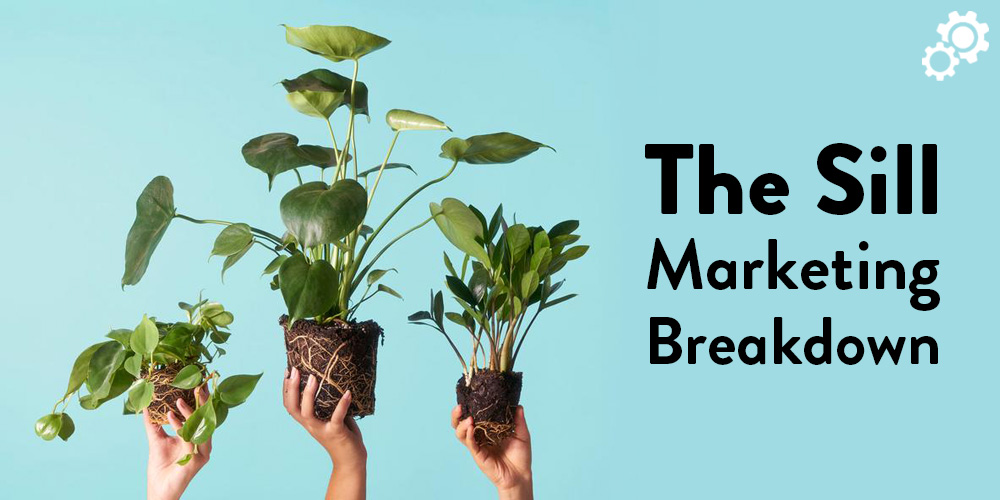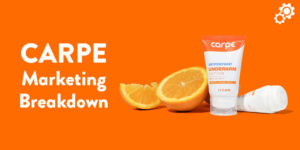According to a Trends Report I read back in June of 2019, Americans spend $48B a year on plants. That’s a lot of plants. It’s also where I first learned about The Sill, one of the few fast-growing D2C players in the space.
According to the same Trends report, The Sill, a NY based startup founded by CEO Eliza Bank in 2012, grew 200% to 500% a year through 2016, according to Blank. In 2018, the company shipped more than 100,000 plants and did more than $5m in sales, a nearly 300% increase from 2017. They’ve also raised about $7.5M in funding over that period.
That was pre-COVID. I think we can safely say 2020 has been a monster year for any D2C player in this space as more and more people are spending time at home. Here’s a Google Trends snapshot for ‘The Sill’ –

As I dug more into The Sill, the more fascinated I became with their marketing tactics and strategies.
The Sill Marketing Tactics Overview:
- Thoughtful product categorization
- Simple content strategy with massive organic search results
- Build a community (and boost CLV) with workshops
- Product visualization with UGC
- Storytelling with product names
- Increase AOV with ‘Need a little more?’
- Plant subscription options to boost CLV
- Powerful one-click to checkout option
Let’s get into the breakdown.
1. Make it easy to get started with thoughtful product categorization
When you have a large product catalog, shoppers can find it overwhelming to find the right product for them. It’s the classic more options = more anxiety = fewer actions taken.
The Sill does a great job of guiding you to the right place right from their main menu:
Just getting started with home plants? Hit the beginner button. Looking for plants that your furry friends can make amigos with? Hit the pet friendly option.
Compare this experience to your typical category page with endless options that the customer has to sort through. By thoughtfully categorizing your products, you help guide your shoppers to take the next step in their journey (that is personalized to them).
Your key takeaways:
- Organize your products into catalogues that make sense for your shoppers (especially if you have a high volume of product offerings).
- Make it easy to find specific products or product categories for different types of shoppers (new shoppers, returning shoppers, etc.).
2. Simple content strategy with massive organic search results
The Sill has a fantastic (and simple) content strategy.
According to Similar Web, more than half of The Sill’s traffic is coming from search (with about 82% of it coming from organic search, 18% from paid search) –

Source: Similar Web
What that means: these guys are absolutely crushing the SEO game!
They have lots of great, very easy-to-consume content to educate yourself regardless if you’re new to the plant game or if you’re looking for how to take care of a Phalaenopsis Orchid.
But let’s zoom out.
The first thing you’ll notice is that they employ the same level of thought to their content categorization as they do with their product catalog. This makes it easy for readers to find what they’re looking for.

Each post is short, sweet, to the point and built around a specific keyword.
Sure they’re targeting top of funnel keywords like plants, potted plants, etc. But their real success comes from targeting long tail keywords like –
bird of paradise – 110K/mo search volume
monstera plants – 60.5K/mo search volume
white orchidee – 12K/mo search volume
In fact, according to SerpStat they are ranking for over 50,000 keywords!
So the game-plan(t) here is simple: for each plant in their catalog, they write a post title: ‘How to Care for X Plant’ and because it has very little competition, it often ranks on page one from the outset.
The interesting thing: these aren’t your meaty 1,000 word + in-depth articles. They use the exact same template for every single post and each post is about 250 – 300 words. My guess is it takes them 15-30 min to piece one of these together.
Here’s an example –
Keyword: the bird of paradise
Search volume: 135,000/mo

Then The Sill goes out and writes a quick article titled Word on The Bird of Paradise –

And boom they’re ranking in the top spot on Google. Hand clap.
Bonus: Each post also leads to a lead capture sign-up form where they can continue to educate the shopper on their plant needs – everything from how to choose the right plant to how to care specifically for a Parlor Palm. I encourage you to sign up to their list just to see how they set it up.

Your key takeaways:
- Think about how you are categorizing your content on your site or blog so your readers can easily and quickly find articles they are looking for (care about).
- Research long tail keywords you can build into your content strategy.
- For long-tail keywords with high variation, put together a content production template you can use to quickly create (our outsource) a high volume of content.
3. Build a community (and boost CLV) with workshops
At The Sill, they offer workshops both in-store and online that you can join to learn about plant care.

Talk about a great way to 1) build a community, 2) create another easy revenue stream that boosts customer lifetime value, 3) build relationships with retail partners, and 4) give customers an opportunity to see and learn about the product before purchasing.
I haven’t tried their workshops, but the Fiddle Leaf Fig 101 workshop had me hovering on the checkout button.
Your key takeaways:
- Think about what your audience is looking for and what they want to learn about that you could create and test a workshop around. For the Sill, it’s workshops like how to care for your plants, or how to mount your plants on a wall that work well. What are ‘how to’ workshops that work for your brand?
- It’s a great monetization tool if you can do it right – create a course or do a live webinar, etc.
- You don’t need a retail spot to bring people together. Consider creating a private Facebook group for your customers where you can educate them.
4. Product visualization with UGC
I find brands often underutilize user generated content.
Remember shoppers want to see what your product looks like in real life and not just in your neatly staged product photo gallery. They want to see and visualize how your product would fit in their world.
The Sill uses a tool called Pixlee to do this –

Yes these UGC photos are fancy but they are, in fact, taken by actual customers.
When you click on any of the images in the Pixlee feed, it lets you purchase the exact product the customer is showing in their photo. Pretty cool.

Here’s the cool thing about Pixlee – it allows customers to upload their own photos to the mix –

There’s an approval process that happens once you submit your photo so you can’t just upload your random vacation photos to the brand’s UGC grid (I tried).
What this tactic does is simple – 1) it allows shoppers to visualize what the product would look like in their world, and 2) it gives customers a way to join the community and further connect with the brand.
Your key takeaways:
- Think about how you can use tools to show shoppers what your product looks like in real life.
- You don’t need a tool like Pixlee to make this happen. You can pull photos from your Instagram feed and share them on your website (Pura Vida does this well).
- An easy place to start is to use your product thumbnails to show photos of people holding / using the specific product.
5. Storytelling with product names
We know storytelling is powerful, so I’m surprised I don’t see this tactic used more often.
Instead of your standard bullet-point product descriptions you see on cookie cutter eCommerce sites, The Sill has a story (plant bio) for every single plant in their catalog.
Here’s one for the Echeveria Preta (who comes up with these names?) –

Side note – one great example of storytelling I saw was on the show Self Made on Netflix. Go watch the first episode and listen to how the main actress tells the story of how her hair grower changed her life to a group of women at the market – you’ll see how powerful storytelling can be when it comes to marketing / sales.
Your key takeaways:
- Think about what story you can tell about your product(s) – where is the product made, where are the parts sourced from, what was the inspiration around it – there is a lot that can be told about a story. Read about the power of storytelling in my Harry’s breakdown.
- Once you’ve found a story to tell, find the right marketing touch points to tell it.
6. Increase AOV with ‘Need a little more?’
You should always be looking to increase your average order value.
The classic “would you like fries with that?” approach works well in eCommerce. I mean Amazon has perfected it with their ‘Customers who bought this item also bought’ section.
Here’s how the Sill does it on their drawer cart. As soon as the Add to Cart button is triggered, a drawer cart pops up as an intermediary step between PDP and checkout.
Notice the ‘Need a little more?’ section –

The goal is to showcase products that work well with the product that they already selected.
If they added a pair of glasses to their cart, offer them a cleaning kit. If the added a phone to their cart, offer them a phone case. Accessories tend to work well. You get the idea.
Your key takeaways:
- Think about what accessories you can offer that complement your product.
- If you already have accessories, consider adding them as order bumps on your main products or give your shoppers the option to add them on their drawer cart or cart page.
7. Plant subscription options to boost CLV
Similar to AOV, you always want to be looking for opportunities to increase your customer lifetime value. There’s no better way to do this than with a subscription offering.
Now this may not be an option for every brand, but The Sill has figured out a way to offer not one, not two, but four different types of subscription services –

Shoppers love collecting and they love convenience so subscription options where they can get a new product to add to their collection on auto pilot is great.
If you’re in the apparel space, accessory space, etc. this is worthwhile testing.
Your key takeaways:
- What extra value can you give your customers for a small annual or monthly fee? Think about special discounts, early access to launches and new products, exclusive workshops, free shipping on all orders, community events, etc. You just need to be creative.
- Think about what segments of your customers would be interested in a subscription offering. One option is to launch a VIP program.
- A great book to reference for this is Pat Flynn’s Superfans. He’s got a ton of great ideas on how to bring your subscribers from finding out about you to raving about you.
8. Powerful one-click to checkout option
This is one tactic you won’t see many brands using. At least for now.
But while you may not have seen it used on other Shopify sites, you’ve likely experienced it yourself. If you’ve ever purchased a book from Amazon, you may have used their Buy With 1-Click option where by simply clicking the button you place the order.
The Sill’s one-click to checkout option works in a similar. The goal is to streamline the purchasing process for the shopper and cut out a few steps in the journey.
Typical journey: Homepage > Catalog > Product Page > Cart > Checkout
The one-click to checkout journey: Homepage > Checkout
Because The Sill is utilizing Shopify’s powerful checkout platform, if the shopper has made a purchase on any other Shopify store (which is likely), all the checkout information is already populated.
That means a shopper can land on the homepage and make a purchase with just 2 clicks. That’s insane!

Now I’ve seen them test different offers with the one-click option. I’ve seen them test the one-click option with their starter plants, but have since updated to a one-click gift card. So it could be different when you’re reading this. Either way, it’s powerful.
Your key takeaways:
- How can you streamline the purchasing journey for your shoppers? How are you minimizing the friction points from landing on your site to placing an order?
- The one-click to checkout option would require a bit of technical wizardry, but if you have a product that requires very little education (and you have a developer on hand), test it.
The Sill Marketing Summary
The Sill has done an amazing job with their marketing – props to their amazing team.
I’ve listed the marketing tactics that stood out to me, but there are plenty of others – their strong social media presence, their beautiful and thoughtful branding, and their unique and interesting ad strategy to list a few.
Feel free to dig around and see what you find. Just be warned that you might end up with a Snake Laurentii in your cart (or mailbox) before you know it.
Enjoyed this post? Sign up below to get notified when a new breakdown goes live –
✌




